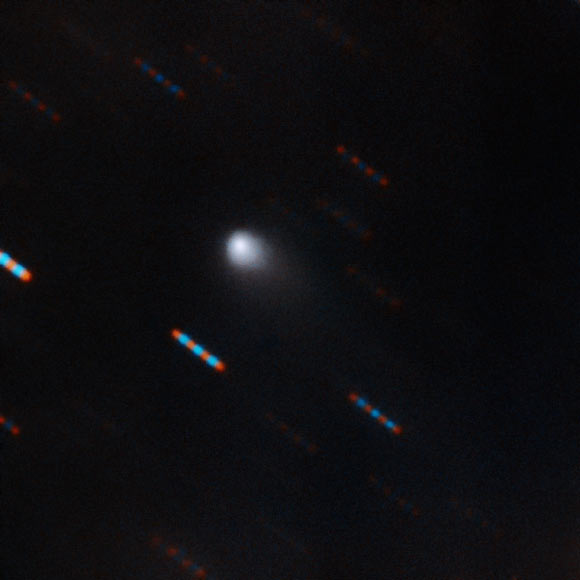Astronomers Detect Cyanide Gas in Interstellar Comet 2I/Borisov | Astronomy – Sci-News.com
Astronomers have for the first time detected cyanide (CN) gas — a common ingredient of solar system comets — in the coma of an interstellar comet.

This composite image, obtained by the Gemini North Multi-Object Spectrograph on the 8.2-m Gemini North telescope, shows 2I/Borisov. Image credit: Gemini Observatory / NSF / AURA / Travis Rector.
CN, often referred to as cyanogen, is a toxic gas made of carbon and nitrogen atoms.
It is one of the most-widely studied gases in solar system comets.
CN in the coma of a comet is thought to be produced when a gas called hydrogen cyanide (HCN) is broken apart by sunlight. It fluoresces at blue and near-UV wavelengths, as well as in the red.
Professor Alan Fitzsimmons of Queen’s University Belfast and colleagues used the 4.2-m William Herschel Telescope (WHT) on La Palma in the Canary Islands to detect this gas in 2I/Borisov, a comet of interstellar origin discovered on August 30, 2019 by amateur astronomer Gennady Borisov from Crimea, Ukraine.
“For the first time we are able to accurately measure what an interstellar visitor is made of, and compare it with our own Solar System,” Professor Fitzsimmons said.
The astronomers observed 2I/Borisov on September 20, 2019. At the time of the observations, the comet was 2.66 AU from the Sun and 3.25 AU from Earth.
“2I/Borisov appears to be similar but slightly less active than many long-period comets — such as C/2013 R1 (Lovejoy), C/2013 A1 (Siding Spring) and C/2014 W2 (PANSTARRS) — observed at similar distances,” they noted.
Combining the WHT spectra with filtered images of the comet obtained with the TRAPPIST-North telescope in Morocco, the team also measured the amount of dust being ejected by 2I/Borisov, and placed limits on the size of the central nucleus.
“Assuming that the properties of 2I/Borisov are similar to regular comets, it implies that the nucleus may be between 0.43-2.05 miles (0.7-3.3 km), is ejecting large grains, and if it is on the small end, the comet likely has a large fraction of the surface active,” the researchers said.
They concluded that the most remarkable thing about 2I/Borisov is that it appears ordinary in terms of the gas and dust it is emitting. It looks like it was born 4.5 billion years ago with the other solar system comets, yet has come from an unidentified stellar system.
The findings will be published in the Astrophysical Journal Letters.
_____
Alan Fitzsimmons et al. 2019. Detection of CN gas in Interstellar Object 2I/Borisov. ApJL, in press; arXiv: 1909.12144






